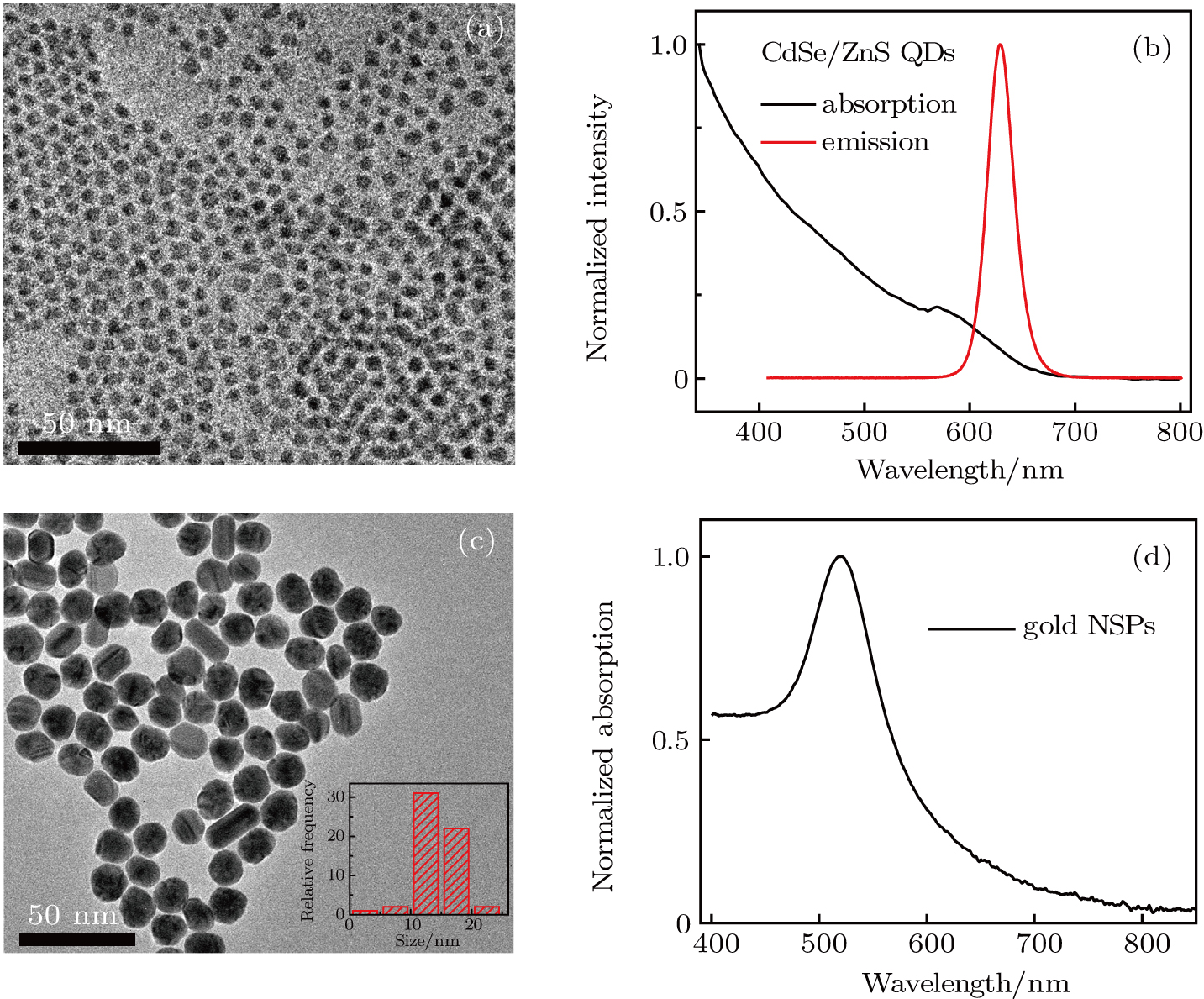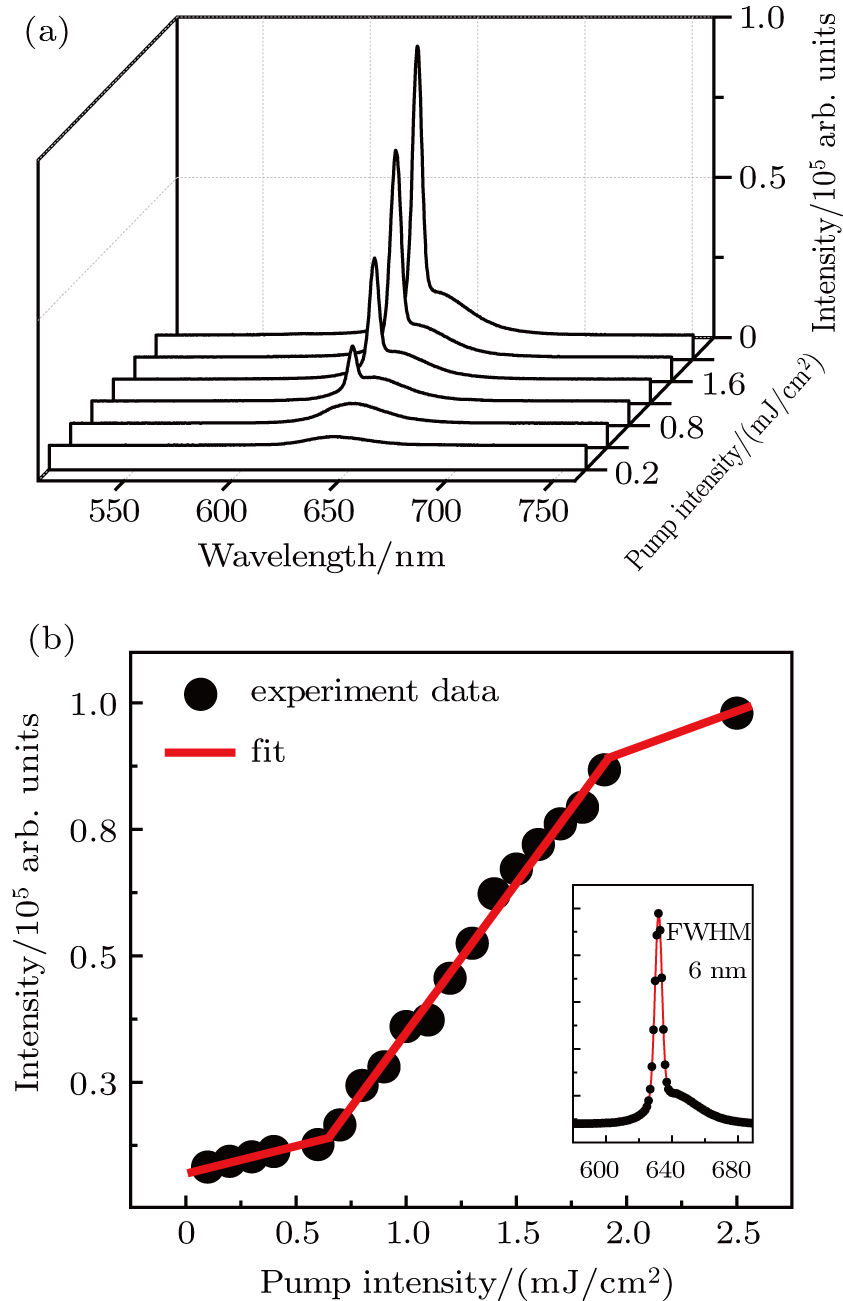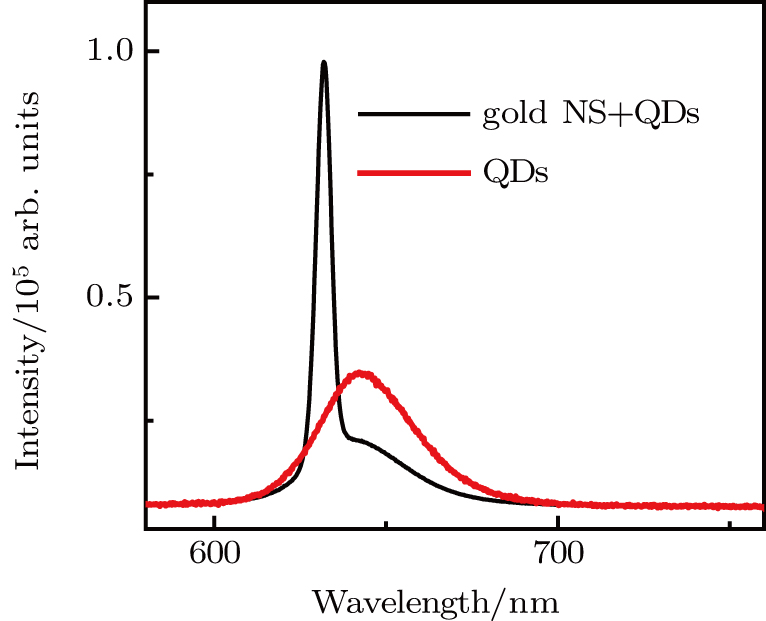† Corresponding author. E-mail:
Here, a plasmon-enhanced random laser was achieved by incorporating gold nanostars (NS) into disordered polymer and CdSe/ZnS quantum dots (QDs) gain medium films, in which the surface plasmon resonance of gold NS can greatly enhance the scattering cross section and bring a large gain volume. The random distribution of gold NS in the gain medium film formed a laser-mode resonator. Under a single-pulse pumping, the scattering center of gold NS-based random laser exhibits enhanced performance of a lasing threshold of 0.8 mJ/cm2 and a full width as narrow as 6 nm at half maximum. By utilizing the local enhancement characteristic of the electric field at the sharp apexes of the gold NS, the emission intensity of the random laser was increased. In addition, the gold NS showed higher thermal stability than the silver nanoparticles, withstanding high temperature heating up to 200 °C. The results of metal nanostructures with enriched hot spots and excellent temperature stability have tremendous potential applications in the fields of biological identification, medical diagnostics, lighting, and display devices.
Compared with the conventional lasers requiring precise fabrication and strict alignment of reflective resonator cavities, the random lasers can be realized by randomly formed closed-loop cavities with metal nanoparticles (MNP) or high refractive index dielectric nanoparticles (DNP) embedded in the gain media.[1–4] The random lasers mainly utilize the interaction between the light and the disordered gain media, thus emitting the light with high intensity and narrow spectral line. Because of the simple fabrication process and low cost, they have potential applications in many fields, including temperature sensors, lighting and display devices, biological identification and medical diagnostics.[5–8] To obtain random lasing, the scattering intensity of the gain medium should be as large as possible to achieve a larger gain volume.[9] In previous random laser studies, researchers usually use DNP with high refractive index and good scattering ability as scatterers, such as TiO2, SiO2, ZnO, and so on.[10–13] The scattering intensity of this random laser can be enhanced by decreasing the average free path of scattering, thus reducing the threshold of random laser and obtaining the random laser with higher intensity. In order to reduce the average free path of scattering, it is necessary to increase the scattering cross-section or the concentration of DNP.[10,12] However, the larger size or higher concentration of DNP will easily lead to aggregation and precipitation, and the stability of the system cannot be guaranteed.[12] Worse still, some DNP have a significant photo-degradation effect on the gain medium, for example, when TiO2 was used as scatters, the intensity of the output random laser is only one-fifth of the initial value after 4500 pump pulses.[10]
Recently, MNPs have attracted a great deal of attention for their unique localized surface plasmon resonance (LSPR) properties.[14–18] Compared with DNP, MNP have significant advantages. The scattering cross-section of MNP in visible light is much larger than that of DNP with the same size, especially when the particle size is less than 100 nm. Researchers usually choose silver nanoparticles when using MNP to enhance fluorescence emission because silver has better LSPR properties in visible light.[19–21] However, the thermal stability of silver is a great challenge in the laser excitation experiment, because the pump source generates great heat by high pulse energy. At present, the thermal stability of silver nanoparticles has been studied both theoretically and experimentally.[22–24] The results showed that the morphology of silver nanoparticles became deformed at 95 °C for 10 min.[24] Therefore, the silver nanoparticles cannot meet the need of some lasing experiments with ultra-high pump pulse energy. However, gold nanostructures showed extremely high thermal stability, which was an ideal choice for laser experiment. In Xiaʼs experiment,[25] the fragmentation of the gold plates was not seen until heating at a temperature of more than 450 °C. However, the thermal stability of nanostructure with enrich hot spots is rarely studied. Hot spots can produce a strong local electric field,[26,27] which greatly enhances the emission characteristics of the gain medium, especially for random laser.[17] The hot spot effect of MNP is closely related to their morphology, size, and composition.[28–31] At present, researchers have exerted a great deal of effort in the preparation of high-yield metal nanostructures with controllable morphology, which is also a field worthy of research.[32] Therefore, advanced engineering to obtain metal nanostructures with enriched hot spots and to further study MNPʼs thermal stability are of current interest for exploration.
In this paper, we demonstrated a type of random laser in the gain medium film by introducing an enriched nanostructure as scatterer. The synthesized gold nanostars (NS) nanostructure with the apexes structure have a hot spot effect due to the strong electric field distributed at its sharp apexes, which lead to plasmon scattering enhancement. The heating experiments of the gold NS show that the apexes structure of the gold NS still keeps stable at 200 °C. The realization of random lasing is mainly attributed to the remarkable scattering of gold NS in the system. For our random laser system, in which gold NS are used as scatters, a random lasing with a bandwidth of 6 nm is obtained. The results reported here provide a straightforward and simple method for plasmon random lasers with multiple scattering based on complex morphologic scatterers.
Polyvinyl pyrrolidone (PVP, MW ∼29000), silver nitrate (AgNO3, 





The structural features of the gold seeds, NS and CdSe/ZnS QDs were detected with scanning electron microscope (SEM, Zeiss Ultra Plus, Germany) and transmission electronic microscopy (TEM; Fei Tecnai T20, USA). Extinction spectra were measured with the fiber optic spectrometer (NOVA, Ideaoptics Technology Ltd., China). The femtosecond Ti:Sapphire laser system (Legend-F-1k, 800 nm, 1 kHz, 100 fs) was used in the excitation pulses experiment. The 400-nm pumping beam was realized through a β-barium borate (BBO) crystal. A fast optical multichannel analyzer (OMA, Spectra Pro-300i) was used to collect the emitted beam at the edge of the sample.
A 100-mL solution with concentration of 1-mmol/L 
A 100-


A rapid assistance-free self-assembly method was used for the fabrication of gold NS film. A pre-cleaned indium tin oxide (ITO) glass slab was put into the untreated gold NS solution. After 12 h, the ITO glass slab was removed from the solution and the surface was flushed with water. Finally, the gold NS thin film was fabricated for the thermal stability experiment.
The 0.7-mL CdSe/ZnS QDs ethanol solution with 0.3 mg/mL was fully mixed with 0.1-g PVP and stirred for 30 min at 600 rpm. Then 300-
The dispersion characteristics of QDs are very important for the preparation of uniform random laser gain medium thin films. To evaluate the dispersion of CdSe/ZnS QDs, we measured their dispersion properties using TEM, as shown in Fig.
To obtain high-quality random laser, we prepared gold NS nanostructures with many sharp apexes by the seed-growth method. Figure
In our experiment, we used a typical vertical pumping, lateral detection experimental setup, as shown in Fig.
Anisotropic MNP, especially those with lots of sharp-apex nanostructures, have strong near field enhancement properties due to their lightning rod effects.[35] However, the near field enhancement is also accompanied by the generation of heat, which will have an impact on metal nanostructures, especially on the sharp apexes.[36] Once the morphology of metal nanostructures degenerates due to the surrounding high-temperature environment, it will directly affect the stability of the system and even cause serious performance degradation. Therefore, it is necessary to check the relationship between the morphology of MNP and temperature, which can be used to guide some experiments related to high heat. We compared the SEM images of the gold NS at different annealing temperatures. It can be seen from Fig.
To demonstrate the emission properties of the CdSe/ZnS QDs doped random laser sample with gold NS as scatters, we have carried out experimental measurement on them. The random lasing spectrum collected at different pump fluences is shown in Fig.
To evaluate the effect of pump fluence on the intensity of emission, we further studied the relationship between them, as shown in Fig. 

To determine the role of gold NS in random laser devices, we have further studied a kind of reference sample, that is, disordered gain medium thin film without gold NS. The emission spectrum of the two samples at 2.5-mJ/cm2 pumping fluence is displayed in Fig.
In conclusion, we have fabricated high-yield gold NS nanostructures with lots of hot spots and high thermal stability. Then, we have successfully prepared single-mode random lasing with narrow line width using these excellent nanostructures. The plasma-enhanced scattering characteristics of gold NS provide an ideal result with a large scattering cross section, while the surface of gold NS will also produce a strong electric field enhancement because of the hot spot effect induced by the sharp apexes nanostructures. This will greatly enhance the emission characteristics of CdSe/ZnS QDs. Through thermal annealing experiments, we found that the thermal stability of the gold NS is extremely high and can withstand nearly a high temperature at 200 °C. The random laser threshold of 0.8 mJ/cm2 is obtained by measuring the continuous pumping fluences of the sample. With increasing pump fluence, we have realized a random lasing with an FWHM of 6 nm. The comparative experiments show that the gold NS in this disordered gain medium is critical for the realization of random lasing. We expect these results will reward attempts to use plasmon-enhanced random lasing in temperature sensors, lighting, and display devices applications.
| 1 | |
| 2 | |
| 3 | |
| 4 | |
| 5 | |
| 6 | |
| 7 | |
| 8 | |
| 9 | |
| 10 | |
| 11 | |
| 12 | |
| 13 | |
| 14 | |
| 15 | |
| 16 | |
| 17 | |
| 18 | |
| 19 | |
| 20 | |
| 21 | |
| 22 | |
| 23 | |
| 24 | |
| 25 | |
| 26 | |
| 27 | |
| 28 | |
| 29 | |
| 30 | |
| 31 | |
| 32 | |
| 33 | |
| 34 | |
| 35 | |
| 36 | |
| 37 | |
| 38 | |
| 39 | |
| 40 | |
| 41 | |
| 42 |






